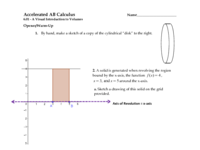
Finding the Area Between Two Curves
Move the sliders or change the functions to approximate the area between two curves.
Finding the Area Between Two Curves
Volumes - Discs (Perpendicular to the x-axis)
Instructions
Use the following Geogebra Visualizations to help you as you work through the beginning stages of developing the concept of Volumes of Revolutions - "Discs Perpendicular to the X-Axis."[br][br]More resources to come!!
6.01 Volumes of Revolution - Disks
Visualization of a Single Washer
Instructions
Play around with the visualizations and they uses them to help you develop a basic understanding as you begin to work on "6.02 Volumes of Revolution - Washers" Use the other GeoGebra Activities in this chapter to help guide your geometric understanding of the calculus.
A "BEHIND-THE-SCENES" view: Here, f and g (graphs not displayed) are constant functions.
Quick (Silent) Demo
Solids Formed From Certain Cross Sections
[b]This applet illustrates solids formed by "prism stacking". [/b] [br][br]Various possible cross-sections are shown to the left. Select any one you'd like. [br][br]f = greater (upper) function[br]g = lesser (lower) function[br]n = number of equal intervals into which the interval [a, b] is divided. [br][br]Note: Cross sections are drawn parallel to the y-axis. [br][br]Enjoy!
Quick Demo. (BGM: Andy Hunter)
Areas & Volumes: Culminating Activity
[b][color=#0000ff]For each exercise, write a definite integral, with respect to the indicated variable, that expresses the area or volume being described. Then, evaluate that definite integral using the fundamental theorem of calculus. [br][br][/color][color=#ff0000]Note: The values of each pair of definite integrals (displayed in the same color) should be equal![/color][br][/b][br][color=#980000]1) Area of R1 (Integrate with respect to x). [br]2) Area of R1 (Integrate with respect to y).[br][/color][br][color=#45818e]3) Area of R2 (Integrate with respect to x).[br]4) Area of R2 (Integrate with respect to y).[br][/color][br][color=#ff00ff]5) Area of R3 (Integrate with respect to x).[br]6) Area of R3 (Integrate with respect to y).[/color][br][br][color=#0000ff]7) Volume of solid of revolution formed by rotating R1 about the x-axis[br] (Integrate with respect to x.) [br]8) Volume of solid of revolution formed by rotating R1 about the x-axis[br] (Integrate with respect to y.) [/color][br][br][color=#9900ff]9) Volume of solid of revolution formed by rotating R1 about the y-axis[br] (Integrate with respect to x.) [br]10) Volume of solid of revolution formed by rotating R1 about the y-axis[br] (Integrate with respect to y.) [/color][br][br][color=#b6d7a8]11) Volume of solid of revolution formed by rotating R2 about the x-axis[br] (Integrate with respect to x.) [br]12) Volume of solid of revolution formed by rotating R2 about the x-axis[br] (Integrate with respect to y.) [/color][br][br][color=#ff7700]13) Volume of solid of revolution formed by rotating R2 about the y-axis[br] (Integrate with respect to x.) [br]14) Volume of solid of revolution formed by rotating R2 about the y-axis[br] (Integrate with respect to y.) [/color][br][br][color=#ff0000]15) Volume of solid of revolution formed by rotating R3 about the x-axis[br] (Integrate with respect to x.) [br]16) Volume of solid of revolution formed by rotating R3 about the x-axis[br] (Integrate with respect to y.) [/color][br][br][color=#000000]17) Volume of solid of revolution formed by rotating R3 about the y-axis[br] (Integrate with respect to x.) [br]18) Volume of solid of revolution formed by rotating R3 about the y-axis[br] (Integrate with respect to y.) [/color]
Cylindrical Shell Action!!! (1)
ONE SHELL:
[b]For another detailed illustration, go to [url=https://www.geogebra.org/m/SWBXZQxR]Cylindrical Shell Action!!! (2)[/url][/b]

